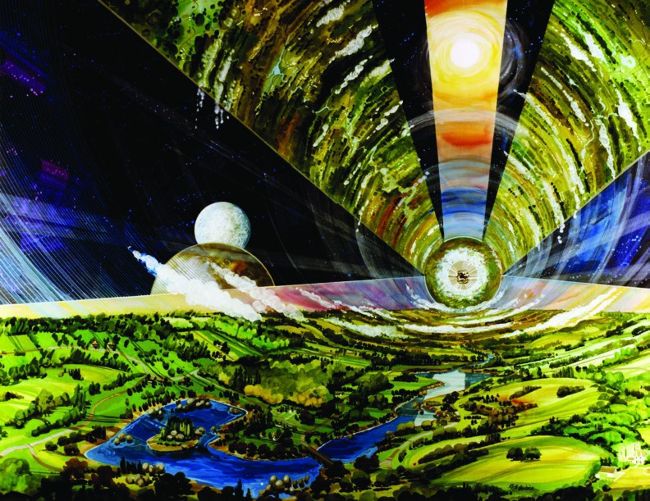ARE SPACE SETTLEMENTS EASIER THAN WE THINK?

A 1970s visualization of an O’Neill Cylinder interior with a
20-mile view down the long axis.
Credit: NASA Ames/Rick Guidice courtesy of NASA.
Say the words “space settlement,” and most people familiar with the term will invariably and immediately think of Dr. Gerard K. O’Neill, the late professor of physics at Princeton University.
“There are good reasons for that,” said Al Globus, a space settlement designer and author. “O’Neill’s vision of humankind’s expansion into space has inspired many people for many years, especially because of his book The High Frontier: Human Colonies in Space.” O’Neill’s seminal book, published in 1977, envisioned large habitats in free space located at Lagrangian points, regions where the gravitational forces between the sun and Earth (and Earth and the Moon) produce stable “parking spots.”
O’Neill suggested various designs for the habitats: massive spherical and torus-shaped structures, plus a distinctive design that has come to be known as O’Neill Cylinders. These consist of a pair of tubes, each as large as 20 miles (32 kilometers) in length and four miles (6.5 kilometers) in diameter. The total land area inside a pair of cylinders is about 500 square miles (1,300 square kilometers) and they could house several million people with enough acreage for farming to feed the inhabitants. The cylinder’s huge size means a gentle spin of one revolution per minute-and-a-half would simulate terrestrial gravity. Children could be born and people could live out their lives in space in one of these colonies and not suffer any of the debilitating effects on muscles and bones that come from living in microgravity.
In O’Neill’s vision, all of these designs could be constructed using raw materials from the lunar surface or near-Earth asteroids, with the materials launched into space using a mass driver and then directed to the colony’s location. The habitats would be illuminated and powered by the sun, and solar power satellites could serve to support the habitats.
“O’Neill’s vision was beautiful, innovative and wonderful, and it has endured for decades,” said Globus. “He showed that space colonies are technically feasible. But these settlements are gigantic, several kilometers across, they weigh millions of tons, and could be over 380,000 miles (600,000 kilometers) away. Now everybody is wondering why they haven’t been built yet.”
“The reason is, they are too darned hard,” continues Globus, a former contractor and researcher at NASA’s Ames Research Center, who has been a long-time fixture in the space settlement community, especially the National Space Society. “These ideas are way too hard to pull off. The space settlements envisioned are too big, too massive, and too far away to be practical, at least as a place to start.”